Surviving a Tax Audit
Tax season looms near. On second thought, when you work independently or own a business, tax season never really ends, does it? IDEA member Tom Holland, MS, owner of TeamHolland: A Fitness Company, found that out a couple
of years ago when his tax return was randomly selected
by the IRS for an audit. Gulp!
Holland recounts the story in detail in the April 2003 issue of IDEA Personal Trainer (pp. 19–23), but here are a few tips from his experience that can help you get organized and keep dependable records.
Documenting Expenses
To help Holland prepare for his audit, his accountant advised him to separate expenses into categories. Consider this as a possible way to track your own expenses throughout the year.
Clothing/Uniforms. This category included the costs of the exercise clothing he wore while either training clients or teaching classes.
Continuing Education. This included the costs of certifications, continuing education courses, CPR training and texts purchased for home study.
Travel Away From Home. This included all out-of-state business-related expenses. In 1999 these costs included his trips to New Zealand and Germany to compete in Ironman® Triathlons. (Holland specializes in training endurance athletes, and this travel and experience moved him to higher positions and pay scales in the facilities where he worked.)
Local Travel. This included the costs of travel to fitness seminars, club meetings and so forth within his home state of New York.
Fitness Equipment. This included the costs of CDs for
cycling classes, microphones, weights and any other equipment he used to conduct his fitness business.
Dues and Subscriptions. This category included dues for the National Strength and Conditioning Association, IDEA and other organizations to which he belongs. It also included the costs of subscriptions to professional trade journals and publications such as Triathlete and Runner’s World.
Miscellaneous. This included the numerous expenses
he incurred that didn’t fall into the other categories.
Holland’s accountant advised him to record expenses in weekly tax records, as in the chart below.
Holland’s audit actually went very well, thanks to his
impeccable organization. He says the process taught him several important lessons:
- Record All Expenses in a Formatted Logbook Right Away. “Both my accountant and the IRS agents may have remarked at how thorough my recordkeeping was, but transferring all of this information into categories and weekly totals took quite a bit of time,” Holland says. “Save yourself time later by categorizing your fitness expenses
as you incur them and keeping weekly totals in an expense record journal.” - Obtain Letters From Your Employers. Ask each of them now for a letter stating that the fitness expenses you
incur are necessary to your job and are not reimbursed. List your specific expenses. - Be Honest. “As stressful as those weeks were (and, trust me, they were), knowing that I had nothing to hide was truly a great feeling,” Holland recalls. “It is much easier to sit in front of IRS agents when you know that you are being truthful.”
- Know What You Can Deduct. Make sure you understand the types of deductions that the IRS allows. Many of the expenses trainers incur are directly related to improving the skills required for the job, and the vast majority of these expenses are not reimbursed by clubs. These can be deducted. Health insurance for the self-employed is another major allowable expense.
If you are a career-minded fitness professional and even if you plan to prepare your tax return yourself, Holland highly recommends investing in a consultation—or two—with an accountant. It can save you time and headache. A tax professional can provide answers regarding whether or not certain expenses fit the criteria of approved deductions, and you can deduct the consultation fee!





